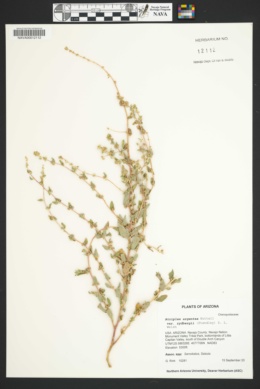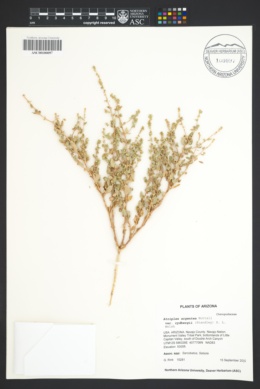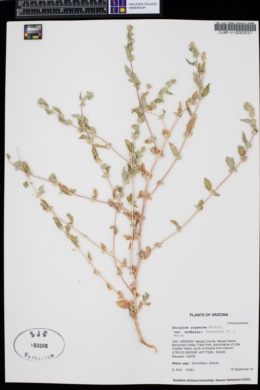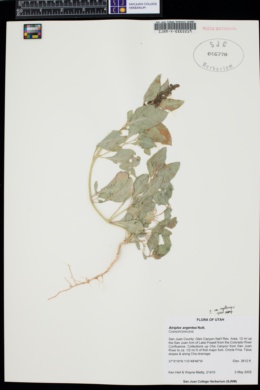Atriplex argentea var. rydbergii
|
|
|
|
Family: Amaranthaceae
|
Stems ascending, erect, (0.2-)1-5 dm. Leaves: blade elliptic to ovate or rhombic, (4-)7-35 × (2-)4-25 mm, base acute to cuneate, margin entire or rarely toothed, apex rounded to obtuse or acute, grayish scurfy. Staminate flowers disposed in axillary glomerules or terminal spikes. Fruiting bracteoles short stipitate (stipe to 4 mm) or subsessile, flabelliform to obovate or suborbicular, compressed, 2.5-7(-8.4) × (2-)2.7-6(-7.5) mm (including stipe length), widest near or beyond middle, united nearly to middle, free portion scurfy, shallowly or deeply and coarsely dentate, sides smooth or with 1 to few thickened processes, and these sometimes again appendaged. Flowering summer-fall. Saline, fine-textured substrates derived mainly from Mancos Shale and Morrison formations and clay or silty alluvium, growing in salt desert shrub and floodplain communities; 1200-2100 m; Ariz., Colo., N.Mex., Utah. In their extreme expression, the leaves of Atriplex argentea var. rydbergii are narrowly elliptic, tapering to both ends, but those extreme forms are connected through a graded series with oval-ovate ones, which tend to maintain the acute-cuneate base, however. The broad-leaved forms are intermediate to var. argentea. Tapering of leaf base to petiole is not restricted to this variety, however. Similar leaf shape occurs rather widely through the species as a whole, but in no place is it so consistently geographically correlated as in the Four Corners region. H. C. Stutz and G. L. Chu (1997) compared their newly proposed Atriplex pachypoda from southwest Colorado and northwest New Mexico with the A. caput-medusae phase of what is considered herein as A. saccaria var. saccaria. Fruiting bracteole shape, marginal tooth arrangement, and compression are so strikingly similar to those of the A. argentea complex that the relationship with the latter group is apparent. Indeed, the closely contiguous var. rydbergii is nearly identical in all except subtle differences in bracteole shape and the disposition of staminate flowers in a terminal spike or panicle, which is apparently not an entirely constant feature. Arrangement of staminate flowers in terminal spikes appears at once to be a striking feature of var. rydbergii, but the spikes are evanescent, often lacking by fruiting time. And, there are some specimens of that variety in which the staminate flowers were evidently mainly, if not entirely, in axillary glomerules. Because of the similarities to var. rydbergii and the inconsistence of characteristics regarded by its authors as diagnostic, A. pachypoda is herein relegated to synonymy.
|















































